For a complete listing of our collections visit our database at http://museums.fivecolleges.edu/
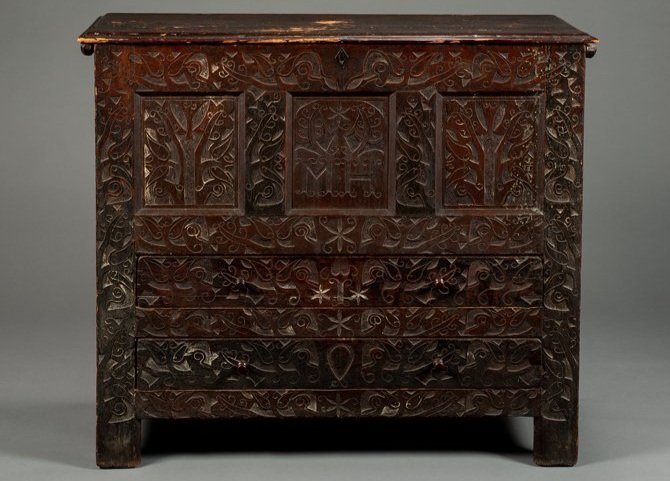
CHEST
United States; Massachusetts ,ca. 1709
Wood: oak, pine; paint
Museum Collections Fund, 2020.22
This chest is carved in the “Hadley chest” tradition with shallow, repetitious tulip-and-leaf motifs covering the façade. The term “Hadley chest” originated with early Hartford collector Henry Wood Erving (1851-1941), who found an example in an old house in Hadley, Massachusetts in 1883 that he described as his “Hadley chest.” Despite the name, craftsmen produced similar, ornately carved chests in other Connecticut River Valley towns, including Deerfield and Hatfield, Massachusetts. Parents commissioned these frame-andpanel chests to celebrate the marriage of their daughters, who likely used them to store textiles when setting up their own households. The initials “MH” on the front center panel of this chest may be those of Miriam Hovey (1689-1713) of Hadley, Massachusetts. The chest was likely constructed around the time of Miriam’s marriage to Benjamin Church (1680-1755) in 1709. This two-drawer chest is a rarer model among extant Hadley chests and survives in a high state of originality with its paint chronology intact.
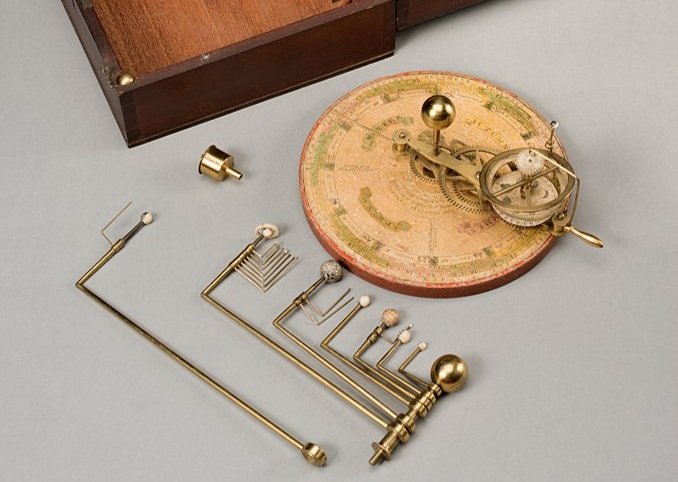
ORRERY
Jones, William
United Kingdom; Great Britain: England; Great Britain: Greater London, London
Wood: beech (probably); metal: brass; ivory; paint; paper
Gift of the Estate of Joseph Peter Spang III, 2021.23.1
According to the best political science of the 1780s, a well-educated citizenry was crucial to sustaining a healthy republic. New England and especially the Connecticut River Valley became a center for education and reform in the early 19th century, with dozens of academies founded to teach young men and women. Many offered a curriculum in English grammar, foreign languages, arithmetic, geography, and science including astronomy and natural philosophy. In 1782, William Jones, a London optician and instrument maker, developed a portable orrery for students and “the use of gentlemen.” Deerfield Academy announced that it had purchased a Jones orrery, described as “a complete Planetarium with Tellurian and Lunarium combined,” in 1808. Tellurian refers to the model of Earth, and Lunarium denotes the model of the moon. The orrery is accompanied by an instruction manual entitled, The Description and Use of a New Portable Orrery, on a Simple Construction, Representing the Motions and Phenomena of the Planetary System… (London, 1812).
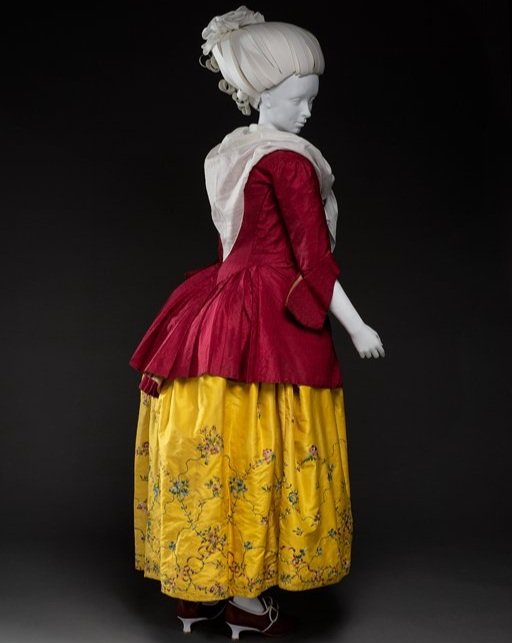
CARACO
United Kingdom (probably), ca. 1775
Textile: red figured silk; white, plain-weave linen; plain-weave linen (buckram); baleen
Museum Collections Fund, 2020.17
Woman’s jacket known as a caraco, made from a red silk decorated with a figured weave. Jackets were an informal and more practical style of dress for women than full-length gowns. Caracos followed the lines of traditional/fashionable gowns of the period, but featuring a hip-length peplum or skirt. Probably first made in the middle of the 18th century, the garment (which may have started out as a full length gown when new) was updated perhaps two decades later, featuring the extreme pointed front and back edges at the hem, reinforced through baleen stays inserted between the fashion fabric and the lining. The garment illustrates the alterations and updating of clothing over time, and is a rare survival of more informal garments for women.
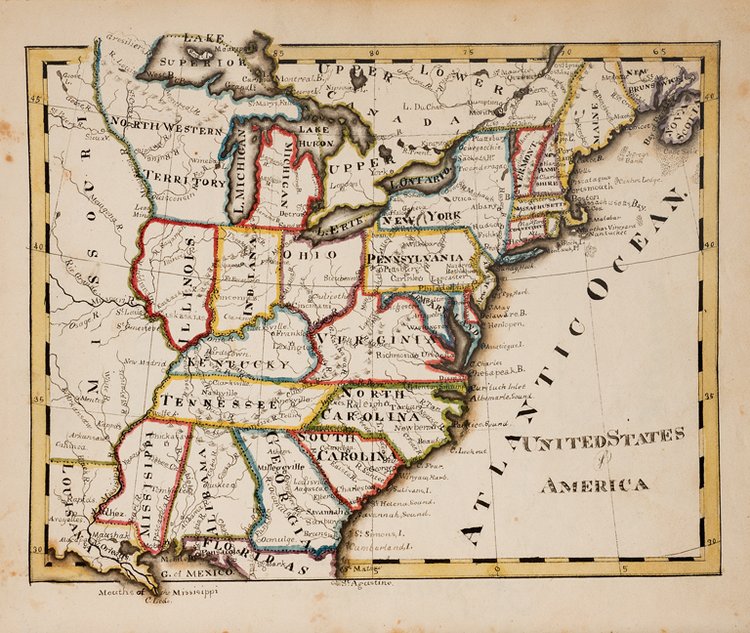
A BOOK OF MAPS
Draper, Emily
United States: Massachusetts: Greenfield, 1822
Paper; ink; pencil; watercolor
Museum Purchase in Honor of David Bosse with Funds Provided by the Deerfield Collectors Guild, 2020.6
This remarkable example of cartographic schoolgirl art contains 19 maps depicting the United States, New England states, New York, New Jersey, Delaware, Pennsylvania, Maryland, Virginia, North Carolina, South Carolina, Georgia, Ohio, Kentucky, and Tennessee. Each is finely executed in pen and ink, with ornamental title cartouches and text; most are hand colored in outline. Emily was the first Draper child born in Greenfield. Her older sisters, Eliza and Hannah, established a school there for young ladies in 1818. Emily most likely created her atlas of maps at that school, possibly basing them on examples printed in Boston in a school atlas by J. A. Cummings. Emily became the preceptress of Deerfield Academy in 1830, and later taught at Miss Draper’s Seminary for Young Ladies, founded by another sister, in Hartford CT.
Manuscript map book (8 3/4 x 7 in.; 222 x 179 mm), finely executed in pen and ink, 56 leaves, including calligraphic title page, 32 pages of calligraphic text and map titles, and 19 full-page maps, 13 partially hand colored in outline. Most maps include very fine figural or ornamental title cartouches.
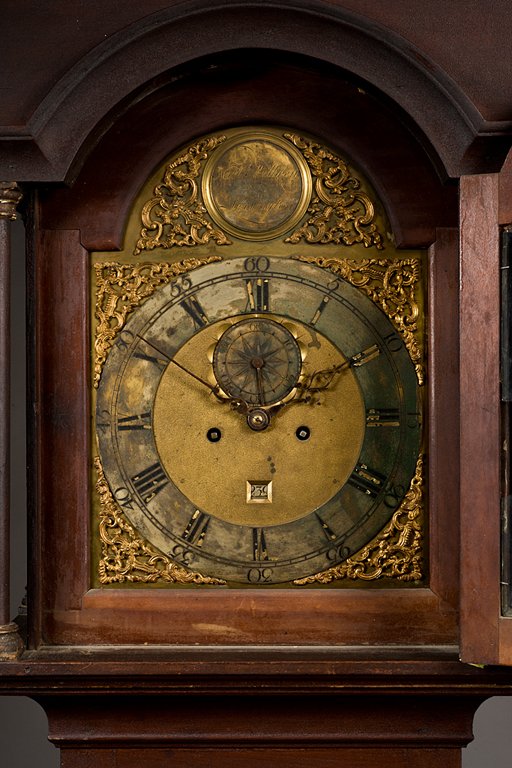
CLOCK
Mulliken, Nathaniel Sr.
United States; Massachusetts: Lexington (1760-1765)
wood: cherry; base metal: brass, silver, lead; glass; gilding
Museum Collections Fund, 2019.37
Made by Lexington, Massachusetts, clockmaker Nathaniel Mulliken, Sr. (1722-1767), this mid-century, urban-inspired, Baroque tall case clock is a testament to the skill of its maker. Mulliken’s clockmaking reveals his proficiency in creating high style work comparable to works made in Boston or even London. His reputation likely encouraged Benjamin Willard (1743-1803), the elder brother of the clockmaking dynasty in Grafton, Roxbury, and Boston, to become his apprentice in 1766. The Mullikens themselves were a multi-generation clockmaking dynasty, and their shop on Lexington Green was torched by the British when retreating from Concord to Boston on April 19, 1775. The clock is in exceptional original condition, and even retains some of the original gilding on the hood’s ball-shaped finials.
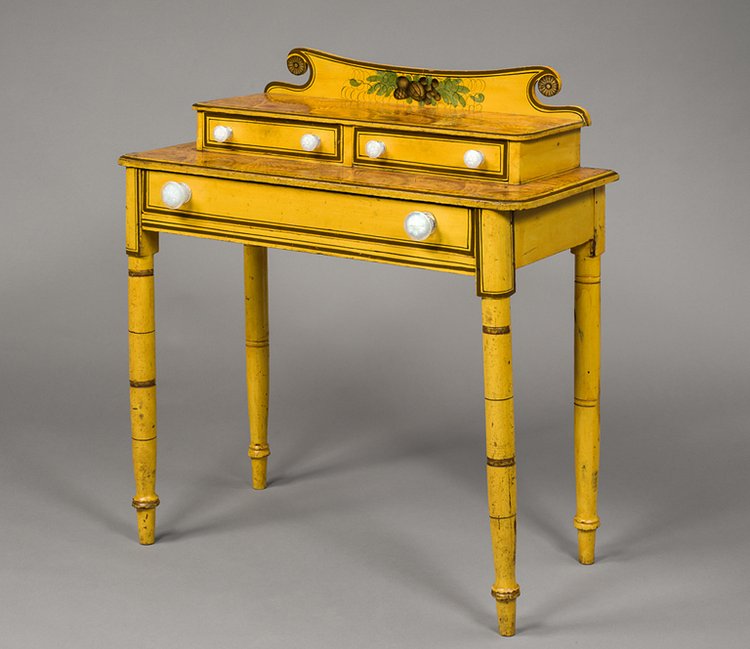
DRESSING TABLE
Harris, David (possibly); Harris, Willard (possibly)
American (David 1803-1855; Willard 1782-1848)
Wood: white pine; paint; glass
Gift of Sarah Sutton Mager and other descendants of Warren and Mary Ann Brown Leverett, 2018.30.1
This painted dressing table en suite with washstand documents the fashion for fancy, or decoratively painted, furniture in the northern Connecticut River Valley. Fancy furniture was an affordable, stylish way to augment an interior, using new colors, motifs, and embellishments on earlier forms of furniture. It was incredibly popular in many areas of the eastern United States from around 1815 to 1840. The dressing table has a stepped arrangement of a long center drawer under two smaller drawers, all with two glass pulls, surmounted by a shaped backsplash with dark-painted trim, with dark-painted rosettes at each end. The legs are turned, and decorated with simple dark-painted circles. The matching wash stand base site on four turned legs, with dark-painted circles and is fitted with a drawer with two glass pulls. The basin has a large backsplash with freehand painted decoration of a garland of fruit and leaves is painted, and a dark-painted border ending in two painted rosettes. Both retain much of their original surface and glass pulls.
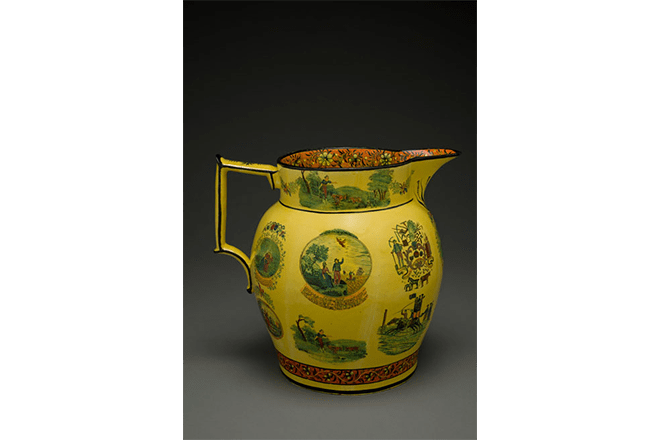
OVERSIZED JUG
Staffordshire, England, ca. 1790
Yellow-glazed earthenware with black transfer printed decoration and overglaze enamels
Gift of Doris and Stanley Tananbaum via the Winterthur Museum, 2017.5.18
Standing approximately 17 inches in height, the jug’s sheer size suggests that it was used for advertising purposes, and placed in a china merchant’s storefront window to attract the attention of prospective buyers. The jug’s plethora of transfer-prints also suggests that it may have sat inside a shop and been used to showcase a variety of images one could have printed on smaller ceramic wares. Of the 16 prints found on the jug (some of which are duplicates) several are Masonic in nature, and likely reflect the public’s fascination with the fraternal organization. Similar yellow-glazed earthenwares were produced in England during the latter years of the 18th century and the first several decades of the 19th century.
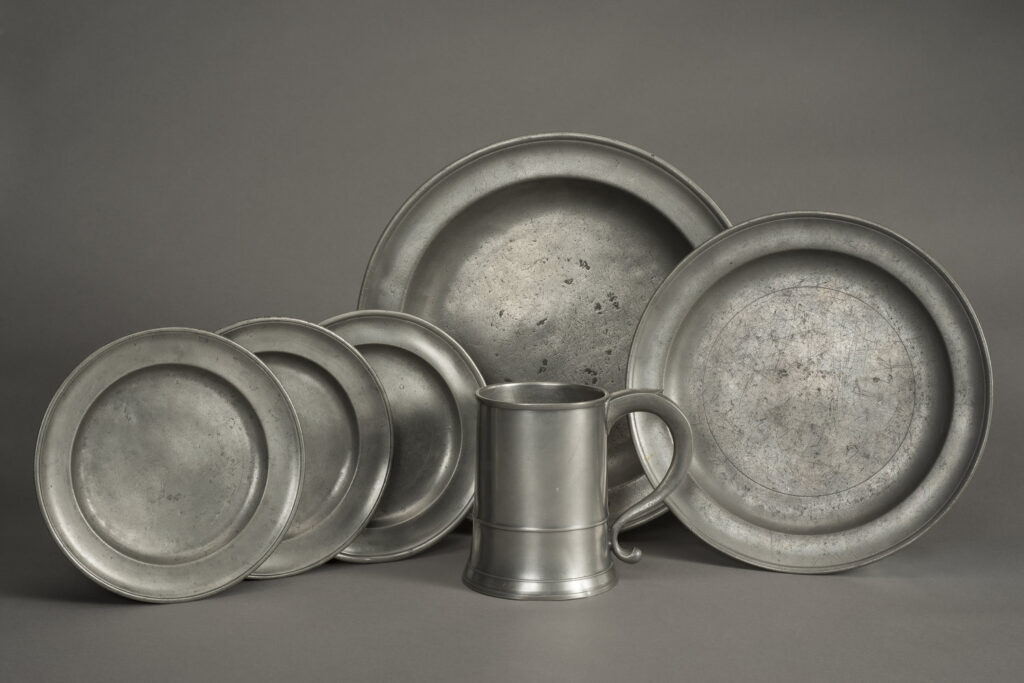
QUART MUG, DISH, AND PLATES
Samuel Pierce (1767-1840)
Greenfield, Massachusetts, 1795-1810
Pewter
Gift of John and Helen Radavich, 2016.38.4-.9
Born in Middletown, Connecticut, Samuel Pierce probably apprenticed in the shop of local pewterer Joseph Danforth. After completing his training, Pierce moved his family to Greenfield, Massachusetts, in 1792 or early 1793, to pursue his trade as a whitesmith at the head of navigation on the Connecticut River. Although his pewter is uncommon today, Pierce produced a wide range of forms (basins, teapots, plates, dishes, porringers, rosettes for fan lights, and baptismal bowls) over the course of his career. In addition to examples of Pierce’s pewter, Historic Deerfield also owns his account books, tools, molds, and the only extant touchmark of an American pewterer.
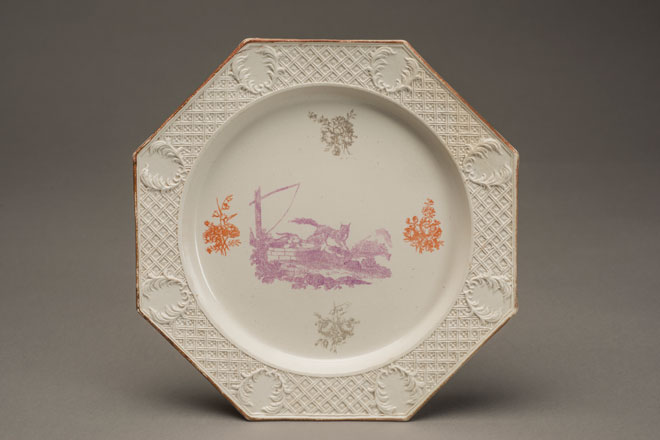
PLATE
Staffordshire and Liverpool, England, 1760-1765
White salt-glazed stoneware with polychrome overglaze enamels
Ray J. and Anne K. Groves Fund for Curatorial Operations, 2017.10
The process of transfer-printing on salt-glazed stoneware did not meet with the same success as printing on creamware. The pitted, salt glazed surface of the stoneware was not as effective as printing on creamware’s smooth, lead glazed surface. Most printing on stoneware appears to have been limited to plates, and in the majority of these examples, the print was created using a single color such as purple, red, or sepia. Stoneware plates printed in multiple colors—such as this example—are therefore exceedingly rare. Current research suggests that the designer of the Aesop’s Fable scene (The Fox and the Goat) located at the center of the plate was Jefferyes Hammett O’Neale, who painted similar fable scenes for the Chelsea porcelain factory.
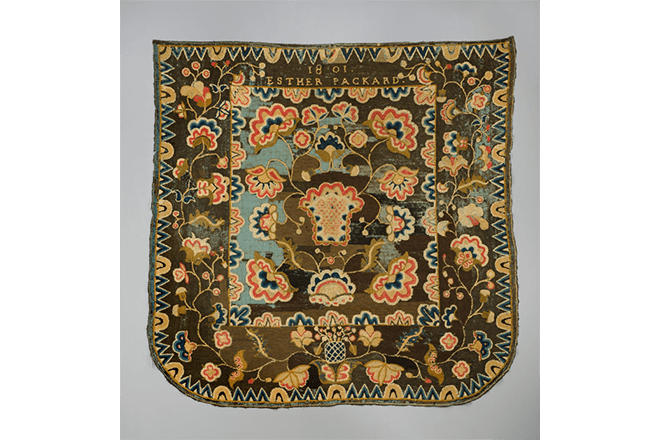
BED RUG
Made by Esther Packard (1733-1812)
Cummington, Massachusetts, 1801
Inscribed “1801/ ESTHER PACKARD.”
Polychrome, 6-ply woolen yarns sewn onto a light blue, plain-weave wool ground
Museum Collections Fund, 2017.6
Pile-sewn rugs added warmth and decoration to beds in the 18th and early 19th centuries. This example was made by Esther Packard of Cummington, Massachusetts, when she was 68 years old. It relates to three known bed rugs in museum collections, one of which is also attributed to a member of the Packard family. Designs decorating many different types of bed coverings, including quilts, embroidered coverlets, and bed rugs, were borrowed, copied, and adapted over many years and succeeding generations.
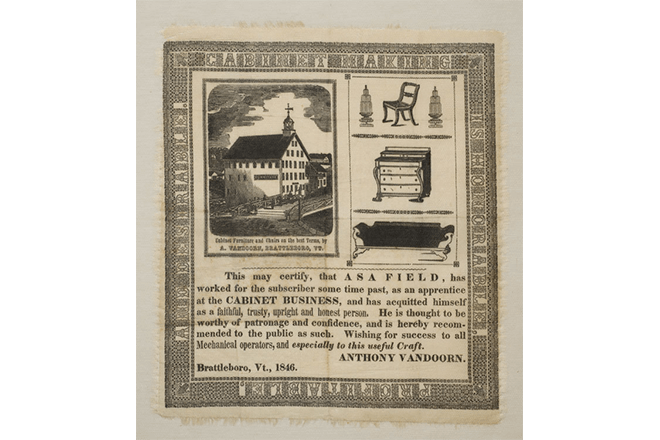
BROADSIDE
Made for Anthony Van Doorn (1792-1871)
Brattleboro, Vermont, 1846
Inscribed “This may certify that ASA FIELD, has worked for the subscriber some time past, as an apprentice at the CABINET BUSINESS, and has acquitted himself as a faithful, trusty, upright and honest person. He is thought to be worthy of patronage and confidence, and is hereby recommended to the public as such. Wishing for success to all Mechanical operators, and especially to this useful Craft. ANTHONY VANDOORN. Brattleboro, Vt. 1846.”
White plain weave silk, black ink
Hall and Kate Peterson Fund for Paintings, Prints, Drawings, and Photographs, 2016.21
Cabinetmaker Anthony Van Doorn moved to Brattleboro from Rhode Island in 1815 where he established a shop west of town. In 1830, he opened a larger shop on Whetstone Brook where it crosses Brattleboro’s Main Street near the town’s commercial center. There he incorporated steam and water power in his workshop, and operated the largest furniture making establishment in Vermont until 1851. Known examples of his furniture embody the late Federal and Empire styles, fashionable in the central Connecticut River Valley in the first half of the 19th century. This rare broadside, printed on silk, serves as a testimonial to his apprentice, Asa Field, who may have been striking out on his own, while providing the only known printed image of his factory, and examples of Van Doorn’s products.
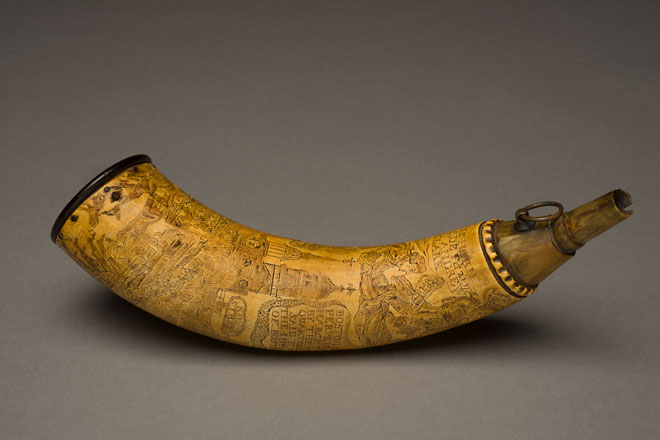
POWDER HORN FOR JOHN AND SARAH GATCHEL
Andrew Clark
Vassalboro, Maine [then Massachusetts], February 21, 1776
Cow horn
Museum Purchase with Funding Provided by the Bartels Trust and Steven I. and Ann du Mont Lord. 2017.13
This powder horn, with exquisite and poignant engraving, is arguably the finest example to survive from the American Revolution. The engraver was a professional—Andrew Clark by name—who was a native of South China, Maine, who served as an artificer, or skilled mechanic, with General Henry Knox’s artillery. Three other horns by Clark are known. Unlike most powder horns, this example had two original owners, and one a woman, John and Sarah Gatchel, who were among the original settlers of Vassalboro, Maine. John served as a guide on the Kennebec River during Benedict Arnold’s ill-fated campaign to take Quebec City a few months before the horn was made. What makes the horn so compelling is that Clark executed the complex engraving on a spiraled and tapering ‘canvas’ depicting in detail two seminal political cartoons of the time: Paul Revere’s Boston Massacre and The able Doctor, or America Swallowing the Bitter Draught (from the June 1774 issue of the Royal American Magazine).
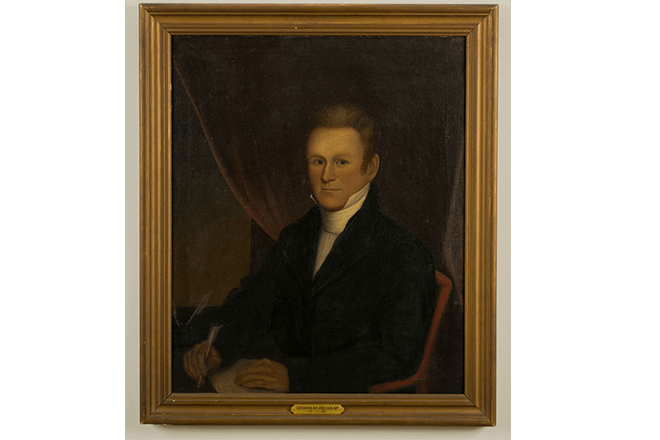
PORTRAIT: JOHN FOSTER STEARNS (1790-1872)
Attributed to Zedekiah Belknap (1781-1858)
Dummerston, Vermont, circa 1832
Inscribed on reverse “John F. Stearns, Esq.” and “Sarah A. Stearns”
Oil on canvas
Gift of William B. Borus and Julie N. Borus in honor of Harold Richardson Borus and Elisabeth Fowle Borus, 2017.8
Zedekiah Belknap was born in Auburn, Massachusetts (near Worcester), but grew up in Weathersfield, Vermont, just south of Windsor. He graduated from Dartmouth College in 1807 with the hope of entering the ministry. Instead, Belknap spent his life painting prosperous farmers and shopkeepers along the Connecticut River Valley and in Massachusetts. The inscriptions on this fine example of Belknap’s work places the painter in Dummerston, Vermont, about 1832 when he portrayed Asa Knight and his wife, Susan, whose store is now at Old Sturbridge Village. The amazing coincidence for Deerfield is that the elder daughter, Susan (1820-1881), of Dummerston merchant, farmer, and magistrate John Foster Stearn was married in 1844 to George Sheldon (1818-1916) of Deerfield, nationally known antiquarian and the founder of the Pocumtuck Valley Memorial Association in 1870.
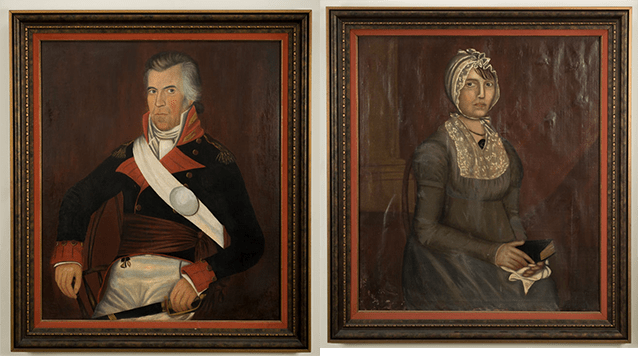
PORTRAITS: GENERAL WILLIAM TOWNER AND LURANA CHADWICK TOWNER
James Brown (active 1806-1808)
Williamstown, Massachusetts, 1807
General Towner signed and dated “J. Brown Pinxt/ Oct 10th 180-” on the reverse, Laura Towner signed and dated “Ja. Brown Pinx [month obscured] 25, 1807” along the top edge of the reverse.
Oil on canvas
John W. and Christiana G.P. Batdorf Fund, 2016.24.1, .2
Williamstown residents General William Towner and his wife Lurana Chadwick Towner were painted in an expressive realistic style by itinerant artist James Brown. Towner was an eminent physician and surgeon, who also served as a Massachusetts state senator and representative. It was said of Towner that “he was a man of graceful exterior and pleasing manners, large and well-proportioned, a courtly gentleman of the olden time, fond of society and always deeply interested in education and politics.” Less is known about Lurana Towner, but her portrait and accessories speak to her refinement, education, and status in the community.
The artist James Brown painted bust length, three quarter, and full length portraits of sitters ranging in location from Williamstown to Plymouth, Massachusetts. Chief characteristics of Brown’s work are the vigorous facial modeling and striking reddish brown coloration. The Williamstown Art Conservation Center has conserved General Towner’s portrait; Mrs. Towner will undergo treatment this year.